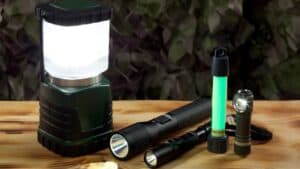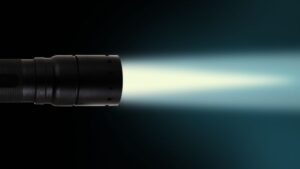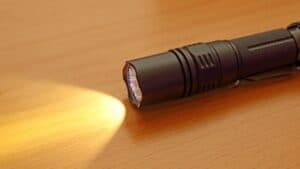Yes, you can bring flashlights on planes in both carry-on and checked luggage. However, the real answer is a bit more nuanced. The Transportation Security Administration (TSA) has specific guidelines you must follow, especially concerning the type of flashlight and, most importantly, its batteries.
This guide will illuminate all the rules you need to know to travel with your flashlight without any hassle.
If you’re sourcing travel-friendly flashlights, contact us directly on the right form for free advice and offerings.
Key Takeaways:
- Standard flashlights are generally permitted in both carry-on and checked bags.
- The most critical rules revolve around batteries. All spare lithium-ion batteries must be packed in your carry-on luggage.
- Flashlights longer than seven inches or those considered “tactical” have special packing requirements and must be in your checked baggage.
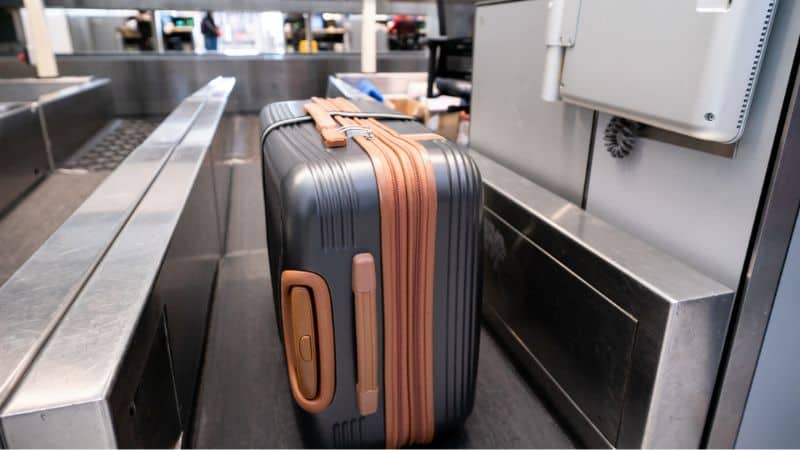
Are Flashlights Allowed on Planes? What the TSA Says
First, let’s look at the big picture. The TSA does not have a blanket ban on flashlights. They are generally considered tools and are permitted for travel. The primary distinction the TSA makes is where you can pack your flashlight, and this often comes down to its size.
The “7-Inch Rule” for Carry-On Luggage
A key guideline to remember is what many travelers call the “7-inch rule.” While not an official term you’ll find on the TSA website, it’s a reliable rule of thumb derived from their regulations on tools.
- Flashlights under 7 inches: If your flashlight is shorter than seven inches, you can pack it in either your carry-on or your checked bag. This covers most common household and everyday carry (EDC) flashlights.
- Flashlights over 7 inches: If your flashlight is longer than seven inches, it must be placed in your checked luggage. This is because longer, heavier tools can potentially be used as a bludgeon.
It’s crucial to remember that no matter the rule, the final decision always rests with the individual TSA officer at the security checkpoint. If they deem an item a threat, they have the authority to prohibit it from passing through.
The Most Important Rule: Traveling with Flashlight Batteries
While the size of the flashlight is a factor, the most critical regulations concern its power source. Issues with batteries, particularly lithium-ion batteries, are the most common reason for travel-related flashlight problems. The rules are in place for a very important reason: safety.
The Critical Lithium Battery Rule
Modern high-performance flashlights and headlamps overwhelmingly use rechargeable lithium-ion (Li-ion) or lithium-metal batteries. These batteries are powerful and efficient, but they also carry a significant fire risk if they are damaged, short-circuited, or exposed to extreme temperatures in the unpressurized cargo hold of an aircraft.
Because of this risk, the Federal Aviation Administration (FAA) and TSA have a strict rule:
All spare lithium batteries—including Li-ion, LiPo, and lithium-metal—are prohibited from checked luggage. They must be carried in your carry-on bag.
This allows the flight crew to quickly respond to any fire or overheating incident in the main cabin. We recommend you place the entire flashlight (with batteries inside) in your carry-on as well.
Understanding Watt-Hour (Wh) Limits
The TSA also places a limit on the size of the lithium-ion batteries you can bring. A single battery must not exceed a rating of 100 watt-hours (Wh). Thankfully, the batteries in virtually all consumer flashlights fall well below this limit.
| Watt-Hour Range | Carry-On Status | Requirements |
| Under 100Wh | Allowed | None |
| 100-160Wh | Restricted | Airline approval |
| Over 160Wh | Prohibited | Not permitted |
If you’re unsure, you can easily calculate the watt-hours of your battery with a simple formula:
(Milliamp Hours (mAh) / 1000) x Voltage (V) = Watt-Hours (Wh)
For example, a common high-capacity Nitecore 21700 battery has a capacity of 5,000 mAh and a voltage of 3.6V. The calculation would be:
(5000 / 1000) x 3.6 = 18 Wh
This is far below the 100 Wh limit, so you’re good to go.
What About Standard Batteries (AA, AAA, C, D)?
If your flashlight uses standard, non-rechargeable alkaline batteries (like AA, AAA, C, or D), the rules are much simpler. These batteries are considered less volatile and can be packed in either your carry-on or your checked luggage, whether they are inside the flashlight or carried as spares.
Special Cases: Tactical and Self-Defense Flashlights
The term “tactical flashlight” can mean different things, but in the eyes of the TSA, it often refers to a flashlight with features that could allow it to be used as a weapon. If your flashlight falls into this category, it must go into your checked luggage.
Look for these specific features:
- Strike Bezels: Many tactical flashlights have a crenellated or sharpened bezel around the lens, designed for self-defense or breaking glass. These sharp edges are a red flag for airport security and will not be allowed in a carry-on.
- Self-Defense Marketing: If the flashlight is explicitly marketed as a self-defense tool or “kubotan,” pack it in your checked bag to avoid issues.
- Multi-Tool Functions: If your flashlight is part of a larger multi-tool that includes a knife blade or other prohibited items, the entire tool must be in your checked luggage.
How to Pack Your Flashlight for a Hassle-Free Airport Experience
Proper packing not only ensures you comply with regulations but also protects your gear and prevents delays at the security checkpoint.
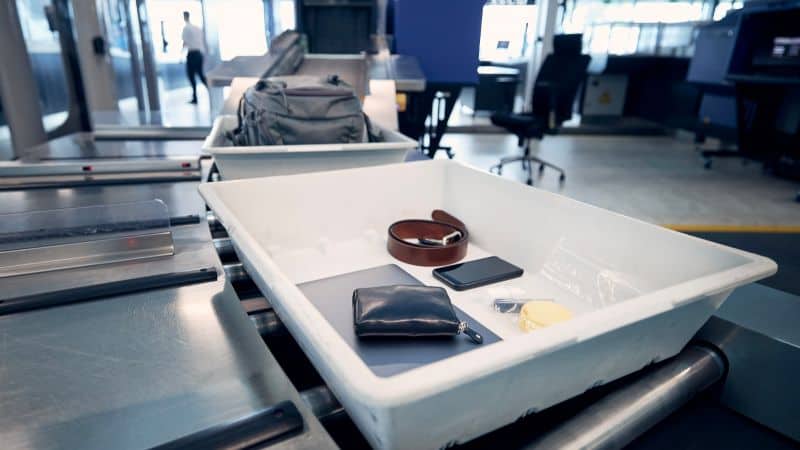
1. Prevent Accidental Activation
A flashlight turning on inside a packed bag can drain the battery and, in rare cases, generate enough heat to become a fire hazard. To prevent this:
- Use the Lockout Mode: Most modern flashlights have a “lockout mode” that disables the power button. Check your user manual for instructions.
- Unscrew the Tailcap: A simple and effective method is to slightly unscrew the tailcap of the flashlight. This breaks the electrical connection and makes it impossible for the light to turn on.
2. Secure Your Spare Batteries
When packing spare lithium-ion batteries in your carry-on, you must protect them from short-circuiting.
- Keep them in their original retail packaging.
- Use a dedicated plastic battery case (the best option).
- Place each battery in a separate plastic zip-lock bag.
- As a last resort, place a piece of non-conductive tape over the battery’s positive and negative terminals.
3. Protect Your Gear
- Carry-On: Keep your flashlight in an easily accessible pocket of your bag. You may be asked to remove it for screening, so having it ready will speed things up.
- Checked Luggage: If you’re packing your flashlight in a checked bag, place it inside a protective case or wrap it securely in clothing to prevent it from being damaged during transit.
Flying with a Headlamp? The Rules are the Same
The TSA does not differentiate between headlamps and handheld flashlights. The same rules apply. If your headlamp is powered by a rechargeable lithium-ion battery pack, it should be transported in your carry-on. If it uses disposable AA or AAA batteries, it can go in either your carry-on or checked bag.
The Bottom Line
Traveling with a flashlight is perfectly fine as long as you follow the rules. By understanding the regulations around size, batteries, and tactical features, you can pack with confidence.
To summarize, always remember:
-
Lithium batteries belong in your carry-on. No exceptions.
-
Flashlights over 7 inches or with aggressive designs belong in your checked bag.
-
When in doubt, check it.
Finally, it’s always a good idea to check the specific policies of your airline and the regulations of your destination country, as international rules can sometimes differ.
Travel safe, and stay prepared!
Frequently Asked Questions (FAQs)
Q1: Can I bring a flashlight in my carry-on bag?
A: Yes, provided it is less than 7 inches long and does not have any weapon-like features, such as a sharp strike bezel.
Q2: Can I pack a flashlight with lithium-ion batteries in my checked luggage?
A: While the flashlight body itself can go in checked luggage (if it’s over 7 inches), all spare lithium-ion batteries must be in your carry-on. For safety and convenience, we recommend keeping the entire flashlight with its lithium-ion battery in your carry-on.
Q3: Do I need to remove the batteries from my flashlight before packing it?
A: It is not a strict TSA requirement, but it is a highly recommended best practice. Removing the batteries or using a lockout mode prevents the light from accidentally turning on, which saves battery life and prevents a potential fire hazard.
Q4: Are there any restrictions on the size of the flashlight?
A: Yes. For carry-on luggage, the flashlight should generally be under 7 inches. There are no size restrictions for flashlights packed in your checked luggage.



